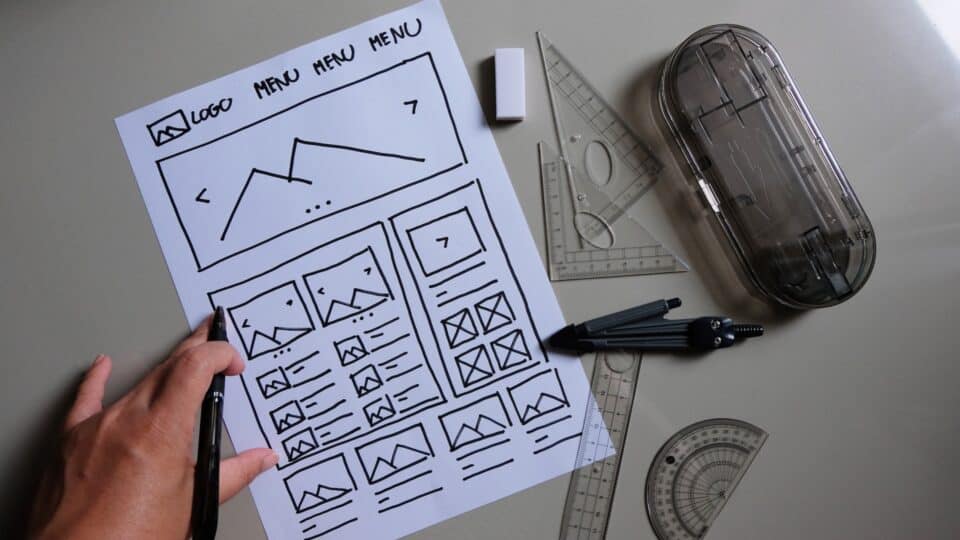In this day and age, it’s hard to imagine not having a website to help drive customers and visitors to your business. A website is one of the first things that most people look for when they discover a new business (alongside any social media, but that’s a different post), and that makes it very important to not only have a website, but it must be up to date, easy to navigate, quick to load, and relevant to the visitors.
There’s no such thing as a perfect website, or a website that is “done.” Because the nature of the internet is that of change, your website should ideally be in a constant state of improvement and evolution. Visitors to your website can be very unforgiving, and if you fail to grab them the first time they visit, it’s unlikely they’ll give you a second chance and return.
Of course, doing a redesign of your website isn’t going to be a magic potion that fixes all of your problems overnight. There are a number of things that go into redesigning, rebuilding, and then remarketing your business website, and if not done correctly you can actually hurt your ranking more than you help it.
Is it really worth it?
Doing a website redesign isn’t something to do just to do. There should be a clear goal in mind, and a process should be laid out. What are your reasons for the redesign? Obviously it’s a big expense, and when business is slow, it might be hard to justify spending the extra money. But sometimes that’s exactly when you should do it, because you have time to devote to it and make sure things are done accurately and in a timely manner (which your web person will love).
Your website can be one of the biggest benefits to your company if it is approached in the correct way. Just know, it takes work and a lot of effort from everyone. If your idea is to throw out some details to a developer and get a completely built website that just works, you are better off just skipping it completely. You should plan to work with your designer and developer to create something that works exactly how you need, instead of expecting it’s going to just “do its thing”.
By no means is a website redesign a small investment, but it is probably one of the most important ones you can make if you’re serious about staying relevant to existing and new customers.
Let’s get into some reasons on why it’s a good idea to redesign your website.
1. High Bounce Rate: Visitors Aren’t Engaging with Your Website
One of the biggest problems that website owners face is that they can’t engage with their customer base. Let’s face it, there are over 130 trillion pages that are searchable by Google, so you are bound to face competition in your market, no matter what it is.
Thankfully, Google is pretty good about keeping things relevant to search terms, location, search history, and so on. But that doesn’t mean you can be lazy when it comes to marketing your website and service or product to visitors.
If your visitors come to your site and feel like it isn’t servicing their specific need (usually a decision made within 2-3 seconds) they will leave right away, which makes your bounce rate go up. Every time someone comes to a website and leaves without visiting any other pages, it counts as a bounce. The goal is to lessen your bounce rate while increasing overall engagement with multiple page visits and session duration. These are metrics that are easily checked with a Google Analytics account, which you or someone definitely should be monitoring.
If you notice a trend of having a lot of visitors but not a lot of engagement, either through phone calls, purchases, comments, etc, then that is an indicator that something is wrong, and it would be a good decision to consider a website redesign.

2. Outdated Design: A Website Revamp Keeps You Competitive
It’s very easy to get focused on your business and forget that your website needs maintenance. Just like a physical store that needs to be cleaned, organized, repainted, and even routinely checked, your website also needs regular TLC.
The most popular recommendation is that your website should be redesigned or at least revamped, every 2-3 years. This keeps things looking fresh and modern, it forces you to clear out products and/or services you may not offer anymore, and it gives you a chance to reevaluate if your current marketing efforts are working or not.
The internet is continually changing and upgrading. In just the past few years we’ve upgraded the base language structures at least a dozen times, and if your website doesn’t update with them, it will break at some point. If that happens, it’ll end up costing you more because you’ll have to pay someone to recover and fix your website in a hurry so you can get back to business.
Keeping up to date with internet language structures keeps your website relevant, and it keeps you safe. Older technology is easier to take advantage of, and the last thing you want is to find your website taken over by someone else. Keeping your website on an old platform or built with old standards is asking for trouble.
And of course, let’s not forget the aesthetic part of all this.
Have you recently done a web search for something, only to land on a website that looks like it hasn’t been updated since 1995? They’re still out there, believe it or not! The problem with this, is that it tells your customers that you don’t care enough about your business to keep it up to date. You might have the best product or service in the world, but if a visitor’s first thought is that you can’t even afford to keep your own business updated, how are you possibly able to help them?
An updated website design helps improve overall user experience, and shows visitors that your business is interested in keeping up with current trends and best practices.
3. Lacking Website Security: Why HTTPS and SSL are Critical for Your Business
It’s no surprise that with the increase of websites and businesses turning to online services, there will be an increase in security and privacy breaches, some that you know about and many that will never even make a blip on your radar. This makes it crucial that your website stay up to date with security protocols as required by internet search engines (like Google), and also other internet technologies that make up the infrastructure of how everything works.
When you have a website, the biggest thing to make sure you have is some sort of SSL certificate to let people know that your site is safe. This has been the standard since at least 2014, but every so often you can still find yourself on a site with a red error icon instead of a nice green lock. It used to be the standard for e-commerce websites where you would enter in sensitive details like credit card numbers for orders, but now the rule is everyone should have one. It’s one of the most important things you should do.
Of course there are other security upgrades you can take to protect your site and online business, and those features would depend on what kind of platform you are building on or built on. If you don’t know how you are being protected, talk to your web person and make sure they know how to protect you. If that doesn’t work, you can always contact us and we’ll be happy to help.
4. Not Mobile-Friendly? The Importance of a Mobile-Optimized Website in 2024
It’s 2024, so it’s probably safe to say that you have a smartphone, and most of the people that you know have a smartphone. Statistics indicate that 3 out of 5 people who visit a website do so from their phone. This means that if your website isn’t mobile friendly (this also means tablets) you’re missing out on potentially critical leads!
It’s also worth noting that mobile-friendly means more than just “works on your phone”. A lot of websites automatically format for phones, depending on what kind of software is used or how your developer coded it, but that doesn’t automatically mean it’s visitor friendly. Is the text large enough to read? Are the buttons spaced out far enough so tapping with a finger doesn’t hit multiple buttons at the same time or maybe the wrong button? There is a lot of user interaction that needs to be taken into consideration to call a website truly mobile friendly.
And lastly, Google now actively hides websites from mobile searches if they don’t have a mobile friendly version of their website (this has been a thing since 2015 or so). If you’re behind the curve, chances are you’re losing potential views and customers and don’t even know it.
5. Broken Links and Pages: How Technical Issues Impact Your SEO and User Experience
One of the most glaring issues a website can have is broken parts. That will turn off a visitor very quickly, and it’s hard to get them to come back. It’s important to check your website for broken pages, missing images, links that don’t go anywhere, and sometimes even stray error messages that appear when things aren’t working quite right.
Missing pages and broken links on your website will affect you in at least two ways, and they can be pretty major.
The first way is straight forward; too many broken pages and people will eventually stop coming to your site. Visitors expect things to work, and they want to find what they are looking for quickly. If the suggested link takes them to a 404 error page, a page with a different topic, or a completely missing section of the website, it isn’t likely that they’re going to spend too much time going through your website to see if you have what they need.
The second problem is that missing pages and broken links will affect your search engine ranking, and it can be difficult to recover from it without investing a fair amount of time. Search engines will index your site pages, and they do that by following links found on your website and other websites. If they lead to broken pages those links are tagged as broken, and the search engines index those pages, your ranking will suffer since your website will be seen as incomplete, not active, or even just not as relevant as your competitors.
Any time your website is updated or content is changed, you should have a check done on all internal links to make sure no pages have been orphaned as a result of optimization. If you don’t know how to do that, we can help.

6. Missing Basic SEO Elements: Boosting Visibility with Key On-Page Optimization
There are some basic guidelines that every website should follow if they have any hopes of showing up in search engines for relevant terms. Of course, SEO is a pretty massive beast, and it’s possible to spend a lot of time, and a lot of money, trying to make it work for you.
However, if you don’t have a huge budget for month to month SEO services, you should still invest in at least a basic level SEO audit and optimization. This includes a couple of items that can be improved upon fairly easily, making your website perform better.
In a basic audit, there are a couple of things that should be checked above everything else. Each page should have the following:
- A unique meta description
- A single H1 tag for a relevant page title
- The page url should be clean and make sense – using dashes and words, not strings of letters and symbols
- Links to other pages on the website
- All images should be optimized in size and resolution
- All images should have an alt tag that describes what the image is
Doing this does not guarantee that you will gain placement in the top of the search results, but it does help your website stay visible. Without these things Google may stop listing your website completely, so only people who know your actual domain link will be able to find you.
7. Outdated Content: The Importance of Fresh, Relevant Content for SEO
Do you know how old the content is on your website? Because even if you don’t, Google does. They continually scan and index websites, looking for new content, updated content, and things that are relevant to what people are actually looking for.
How old is your website? If it’s been around for a couple of years, have you added any new pages? Have you updated your call-to-action buttons? If you haven’t updated the actual content on your website in at least a year, then you are probably hurting your search ranking. Search engines like to show website listings that are actively kept up and providing viable information to visitors. Without updates, they might assume you are no longer actively monitoring or keeping up your website, and they’ll bump you to the back of the search results in favor of businesses that are actively adding and changing content.
It’s suggested that you add and/or update at least 4 pages of content a month, at a minimum. This is why so many businesses start a blog or online newsletter, because these things help keep content fresh and the search engines happy.
8. Inconsistent Branding: Ensuring Your Website Reflects Your Business Identity
With most businesses, as they grow they evolve. Services are added and removed, products are upgraded, and maybe staff changes as well. With these things, most in house assets are changed, like business cards and company emails, but often the website is put on the back burner until someone has time for it.
Or maybe the company has rebranded itself as a whole. You want to make sure that your imagery, colors, and visuals are in line across all platforms, digital and physical, in order to keep your branding cohesive and not confusing.
You also want to make sure that what you tell people about the business syncs up with what they find online. If you no longer offer particular services or products, but you haven’t made that change to your website, you may lose customers who find the conflicting information to be confusing.
9. Hard to Maintain: Why Frequent Website Fixes Signal the Need for a Redesign
A strong indicator that your website might need a redesign is by gauging how much time and money is spent fixing things instead of marketing or building. If the focus seems to be constantly on fixing error messages, replacing broken content, or formatting things that don’t quite look right, then it is definitely time to take a step back and reassess things.
Making changes to your website shouldn’t be something hard to do, or something you dread. And if you hate dealing with it, your visitors are going to hate it even more. When people come to your website they expect to find the information they need quickly, and if they continually run into broken features, server errors, or other issues, they will leave and likely never return.
Not only does that mean you lose out on visitors and potential sales, but now you have to spend time and money constantly calling your web person to fix things.
If that’s the case, it might be time to focus on redesigning and rebuilding to a cleaner specification. If you continually slap bandaids on your website in an attempt to save money (which isn’t what happens) and do quick fixes, eventually the site will either fail or it’ll become so unoptimized that nobody will want to visit it anyway.
10. Strategic Timing: Why Redesigning Your Website During Downtime is Beneficial
It might be hard to believe, but when you have downtime, that is the best time to consider doing major upgrades to your website. It’s hard to manage a full schedule of running your business, keeping everything operating smoothly on a day to day basis, and dealing with a needy web developer (we will need a lot your time) on top of everything.
When business is low it’s easy to feel like you should cut back on expenses, and websites tend to be the first thing that suffer. In reality, it should be exactly the opposite. Take the extra downtime to come up with things you want to accomplish, talk to your developer or a new a company if you need to about a payment plan that works for everyone, and breathe some new life into your digital presence. Not only can it help drive new business for you, but if you are closed for any amount of time (like now), it might give you an edge when things go back to normal.
Still on the fence?
If you look at your site and see it is lacking in one, maybe two, of these areas, it’s probably not worth stressing over and getting into a redesign. If you can see the issues are straight forward and easy to fix, focus on that first. Afterwards make a plan to give your website a thorough review and audit.
Your website shouldn’t simply exist as an extension of your business that sometimes brings in good results. You want it to be a major part of what you do, and if it’s not working then it’s time to reevaluate and make the changes needed to get it back on top.




